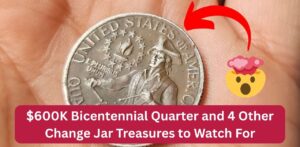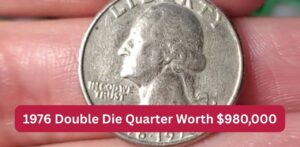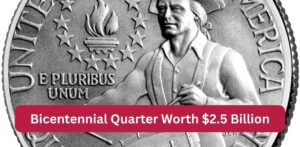Believe it or not, one of the most valuable U.S. coins could still be hiding in your pocket change. The 1976 Bicentennial Quarter, released to commemorate America’s 200th year of independence, has taken the spotlight once again—this time for its surprising market value. While most are common, a few rare variants have sold for as much as $1.6 million. Yes, and they’re still circulating.
Why the 1976 Bicentennial Quarter Is So Unique
To honor the nation’s Bicentennial, the U.S. Mint issued special commemorative designs on quarters, half dollars, and dollar coins. The Bicentennial Quarter features a Colonial drummer on the reverse and the dual date “1776–1976” on the obverse. It was the first major design change for the quarter in decades, making it instantly recognizable and widely collected.
These coins were minted in 1975 and 1976 (with none bearing a 1975 date), and while millions were produced, only a few rare types have skyrocketed in value.
What Makes Some Bicentennial Quarters Worth $1.6 Million?
While most Bicentennial Quarters are only worth face value, rare variants are prized by collectors. Here’s what drives the value into six- or even seven-figure territory:
1. Rare Minting Errors
Errors like double die obverse, off-center strikes, or deep die clashes are highly desirable. One quarter with a dramatic die clash and proof-like appearance sold for $1.6 million after being discovered in circulation.
2. Silver Composition
Most of these quarters were made from copper-nickel. However, a limited number were struck in 40% silver for collector sets. These silver versions are heavier and lack the copper ring around the edge. In excellent condition or combined with an error, they can be worth thousands.
3. Proof and SMS Coins
Proof coins and Special Mint Set (SMS) coins were made for collectors, not circulation. If one of these made it into everyday use—especially with a minting flaw—it becomes extremely rare and valuable.
How to Identify a Rare Bicentennial Quarter
Think you might have a winner? Here are the signs to look for:
- Dual Date: All Bicentennial Quarters should display “1776–1976.”
- Mint Mark: Look for “S” (San Francisco), “D” (Denver), or “P” (Philadelphia).
- Weight and Color: Silver coins weigh around 5.75g and may appear more gray than the typical copper-nickel blend.
- Edge: Silver versions lack the reddish copper stripe along the edge.
- Errors: Use a magnifier to spot doubling, off-center strikes, or unusual marks. Check the drummer’s face, the date, and the torch.
- Grade: High-grade coins, especially those rated MS-67 or above by PCGS or NGC, are far more valuable.
A Coin Found in Pocket Change
One of the most valuable Bicentennial Quarters ever discovered was found during a casual coin roll hunt. The finder had no idea they were holding a fortune. After expert grading revealed a rare double die obverse with a deep cameo finish, the coin sold for a record-breaking $1.6 million.
Should You Get Your Coin Appraised?
If you suspect you have a rare Bicentennial Quarter, here’s what to do:
- Do not clean it — cleaning can reduce the coin’s value significantly.
- Store it safely — use a coin sleeve or case to prevent damage.
- Get it graded — professional grading by PCGS or NGC can confirm authenticity and condition.
- Consult a dealer — a reputable coin dealer or auction house can help assess its market value.
Final Thoughts
In an age of tap-to-pay and digital wallets, it’s easy to overlook coins. But the story of the 1976 Bicentennial Quarter worth $1.6 million proves that real value can still be hiding in your change. Whether you’re a collector or just someone with a jar of coins on the counter, take a closer look—you might be holding a historic treasure.
So next time you get change at the store, check that quarter. It could be worth far more than twenty-five cents.
FAQs
Q1: Can I still find a valuable Bicentennial Quarter in circulation?
A: Yes, although rare, some silver or error varieties may still be in pocket change or coin rolls.
Q2: How can I tell if my Bicentennial Quarter is silver?
A: Check the edge — silver quarters usually lack the copper stripe. They also weigh slightly more than standard ones.
Q3: Where should I sell a valuable coin?
A: Use a certified coin dealer, auction house, or professional grading service for a secure and profitable sale.
Q4: Are all 1976 quarters worth more than face value?
A: No. Most are only worth 25 cents, but coins with mint errors, silver content, or high grades can be worth much more.



